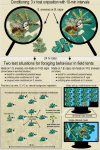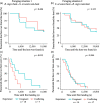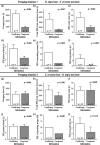Multi-camera field monitoring reveals costs of learning for parasitoid foraging behaviour
- PMID: 33724445
- PMCID: PMC8361673
- DOI: 10.1111/1365-2656.13479
Multi-camera field monitoring reveals costs of learning for parasitoid foraging behaviour
Abstract
Dynamic conditions in nature have led to the evolution of behavioural traits that allow animals to use information on local circumstances and adjust their behaviour accordingly, for example through learning. Although learning can improve foraging efficiency, the learned information can become unreliable as the environment continues to change. This could lead to potential fitness costs when memories holding such unreliable information persist. Indeed, persistent unreliable memory was found to reduce the foraging efficiency of the parasitoid Cotesia glomerata under laboratory conditions. Here, we evaluated the effect of such persistent unreliable memory on the foraging behaviour of C. glomerata in the field. This is a critical step in studies of foraging theory, since animal behaviour evolved under the complex conditions present in nature. Existing methods provide little detail on how parasitoids interact with their environment in the field, therefore we developed a novel multi-camera system that allowed us to trace parasitoid foraging behaviour in detail. With this multi-camera system, we studied how persistent unreliable memory affected the foraging behaviour of C. glomerata when these memories led parasitoids to plants infested with non-host caterpillars in a semi-field set-up. Our results demonstrate that persistent unreliable memory can lead to maladaptive foraging behaviour in C. glomerata under field conditions and increased the likelihood of oviposition in the non-host caterpillar Mamestra brassica. Furthermore, these time- and egg-related costs can be context dependent, since they rely on the plant species used. These results provide us with new insight on how animals use previously obtained information in naturally complex and dynamic foraging situations and confirm that costs and benefits of learning depend on the environment animals forage in. Although behavioural studies of small animals in natural habitats remain challenging, novel methods such as our multi-camera system contribute to understanding the nuances of animal foraging behaviour.
Keywords: associative learning; brassicaceous plant species; cabbage moth; foraging efficiency; large cabbage white butterfly; memory reliability; non-host; parasitic wasp.
© 2021 The Authors. Journal of Animal Ecology published by John Wiley & Sons Ltd on behalf of British Ecological Society.
Figures



Similar articles
-
Habitat complexity reduces parasitoid foraging efficiency, but does not prevent orientation towards learned host plant odours.Oecologia. 2015 Oct;179(2):353-61. doi: 10.1007/s00442-015-3346-y. Epub 2015 May 23. Oecologia. 2015. PMID: 26001606 Free PMC article.
-
To be in time: egg deposition enhances plant-mediated detection of young caterpillars by parasitoids.Oecologia. 2015 Feb;177(2):477-86. doi: 10.1007/s00442-014-3098-0. Epub 2014 Oct 2. Oecologia. 2015. PMID: 25273955
-
Getting confused: learning reduces parasitoid foraging efficiency in some environments with non-host-infested plants.Oecologia. 2019 Apr;189(4):919-930. doi: 10.1007/s00442-019-04384-2. Epub 2019 Mar 30. Oecologia. 2019. PMID: 30929072 Free PMC article.
-
A neuronal arms race: the role of learning in parasitoid-host interactions.Curr Opin Insect Sci. 2020 Dec;42:47-54. doi: 10.1016/j.cois.2020.09.003. Epub 2020 Sep 15. Curr Opin Insect Sci. 2020. PMID: 32947014 Review.
-
Natural variation in learning rate and memory dynamics in parasitoid wasps: opportunities for converging ecology and neuroscience.Proc Biol Sci. 2011 Mar 22;278(1707):889-97. doi: 10.1098/rspb.2010.2199. Epub 2010 Nov 24. Proc Biol Sci. 2011. PMID: 21106587 Free PMC article. Review.
Cited by
-
Olfactory learning in Pieris brassicae butterflies is dependent on the intensity of a plant-derived oviposition cue.Proc Biol Sci. 2024 Aug;291(2028):20240533. doi: 10.1098/rspb.2024.0533. Epub 2024 Aug 7. Proc Biol Sci. 2024. PMID: 39109969 Free PMC article.
-
Perspectives for integrated insect pest protection in oilseed rape breeding.Theor Appl Genet. 2022 Nov;135(11):3917-3946. doi: 10.1007/s00122-022-04074-3. Epub 2022 Mar 16. Theor Appl Genet. 2022. PMID: 35294574 Free PMC article. Review.
-
Megapixel camera arrays enable high-resolution animal tracking in multiwell plates.Commun Biol. 2022 Mar 23;5(1):253. doi: 10.1038/s42003-022-03206-1. Commun Biol. 2022. PMID: 35322206 Free PMC article.
-
The Drosophila-parasitizing wasp Leptopilina heterotoma: A comprehensive model system in ecology and evolution.Ecol Evol. 2023 Jan 23;13(1):e9625. doi: 10.1002/ece3.9625. eCollection 2023 Jan. Ecol Evol. 2023. PMID: 36703713 Free PMC article. Review.
-
A parasitoid's dilemma between food and host resources: the role of volatiles from nectar-providing marigolds and host-infested plants attracting Aphidius platensis.Naturwissenschaften. 2021 Dec 16;109(1):9. doi: 10.1007/s00114-021-01780-8. Naturwissenschaften. 2021. PMID: 34913094
References
-
- Bates, D., Maechler, M., Bolker, B., & Walker, S. (2014). lme4: Linear mixed‐effects models using Eigen and S4. R Package Version, 1(7), 1–23.
-
- Bleeker, M. A. K., Smid, H. M., Steidle, J. L. M., Kruidhof, H. M., Van Loon, J. J. A., & Vet, L. E. M. (2006). Differences in memory dynamics between two closely related parasitoid wasp species. Animal Behaviour, 71(6), 1343–1350. 10.1016/j.anbehav.2005.09.016 - DOI
-
- Bukovinszky, T., Poelman, E. H., Kamp, A., Hemerik, L., Prekatsakis, G., & Dicke, M. (2012). Plants under multiple herbivory: Consequences for parasitoid search behaviour and foraging efficiency. Animal Behaviour, 83(2), 501–509. 10.1016/j.anbehav.2011.11.027 - DOI
Publication types
MeSH terms
Associated data
LinkOut - more resources
Full Text Sources
Other Literature Sources

